Cherry-Rhubarb Jam
May 24, 2012
The rhubarb in the back yard has been calling me for two weeks and only today did I answer. I decided to experiment — it must be the vitamins I take that give me the courage for it. People are fond of strawberry-rhubarb jam, to be sure but since I have more cherries (the University of Minnesota’s own North Star cultivar) in my freezer than I have strawberries, I opted for cherry-rhubarb jam.
Finding a recipe proved to be a challenge; the closest I came was for a strawberry-rhubarb jam recipe in the Ball Blue Book. Though it did not involve cherries, it did give me a place to start as far as amounts of fruit and sugar. Next time I make it, though, I will use less pectin; it was thicker than it should be. I’ll have a better feel for that after I have some for breakfast tomorrow.
Cherry-Rhubarb Jam
1 pound frozen sour cherries, thawed and chopped (2 cups)
1 pound thinly sliced rhubarb, cooked until tender (about 5 minutes) with 1/3 cup water (about 1-3/4 cups cooked)
6 tablespoons powdered pectin
5 cups granulated sugar
Yield: About 6 half-pint jars of yummy homemade jam.
Prepare six half-pint canning jars and lids and keep them in simmering water until they are ready to be filled. My habit is to set the clean jars to “cooking” in the potful of boiling water that I will process them in (I use a 10-quart Farberware stainless steel stockpot) when I start making the jam. If you have hard water, the addition of a glug (the scientific measure) of white vinegar will eliminate any mineral deposit on the glass jars.
For the jam: Combine the chopped cherries and the cooked rhubarb in a large (at least 6-quart capacity) non-reactive kettle, stir in the pectin, and bring to a boil over medium-to-high heat, stirring. My workhorse cooking pot is a Bigass™ Demeyere kettle that I paid $165 for at Sur la Table in Seattle in 1998. That was my souvenir from the trip and when I croak, its next owner will be named in my death documents. You can sign up now, if you want a shot at it. You should know that I can be bought.
When the fruit and pectin are at a good boil, stir in the sugar all at once, being certain there are no clumps of sugar in the fruit. (Really, it is not likely that there will be any, but just in case. . . .)
Bring the mixture to a hard boil and time that boil for one minute. Remove the kettle from the heat, then stir it slowly for about 5 minutes and skim any foam from the surface. My weapon—er, utensil—of choice for the skimming task is the bottom of a flat fine mesh skimmer much like the one pictured in this link. These skimmers are not difficult to find (try Tuesday Morning or TJ Maxx) – you can be sure I did not pay $50 for mine, though I may have paid $20. While this is not a must have, it makes the task pretty darned easy. Just set the skimmer on top of the foamy jam in the pot and lift it up. Rinse the foam off, pat the bottom of the skimmer with a clean towel, and repeat until the foam is off the jam.
Between stirs and skims, remove the jars from the hot hot water and invert them onto a clean towel on the counter. Drop the flat lids into the water and let them sit there while you fill the jars with your ruby red jam. Fill to about 1/4” from the top of the jar, wipe the lip of the jar with a clean damp cloth or paper towel, set a hot lid on top, and add the screw band, twisting it only fingertip tight. Years ago, my local University of Minnesota Extension canning specialist taught me to screw it on using my thumb and middle finger—you are less likely to overtighten the ring. It’s my habit now.
Using a jar lifter, carefully put the filled and covered jars into the canner and hot water for processing. The water should cover the jars by 1-2” and there should be another couple inches to allow for boiling during the sealing process. Process jam for 5 minutes (at altitudes to 1000 feet) in lightly boiling water, then remove them to a towel on your counter (I prefer to use my breadboard) and let them stand undisturbed for several hours or overnight. You can towel off any water on the top of the jar lids.
When the jars are cold, remove the rings and wipe the jar. Replacing the ring (which you will have also dried on the inside) or not is a matter of preference. I put mine back on — the last thing I need is 200 canning jar rings loose (or contained!) in my house. Label the jars and store them at cool room temperature for later enjoyment.
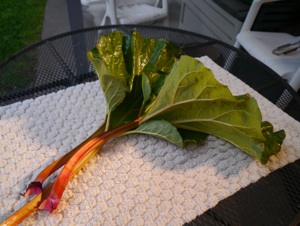
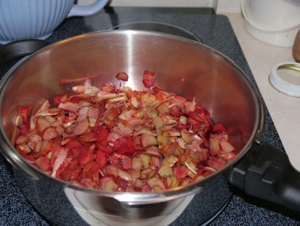
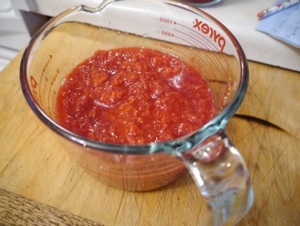
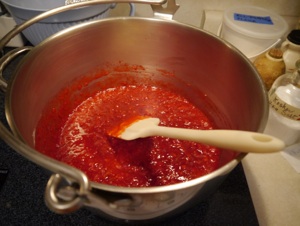
That wasn’t so hard, was it? You’ll get faster the more you do it. It took me about 45 minutes to make this batch from start to finish. I can’t wait to try it on an English muffin tomorrow.
And now is tomorrow. . . and, boy, does this need work. Many, many years ago I made a batch of strawberry jam by simply cooking the berries and sugar together, until they had thickened to jam. Hah! Thickened to mortar is a more apt description. I had overcooked it, not trusting that it would thicken more on cooling. Live and learn.
Yesterday’s cherry-rhubarb jam was a reminder of that long-cook strawberry jam of years past. It is too stiff. Tasty but too stiff – you can see it in the first two pictures below. Jam is crushed fruit, in a thick gel. Jam is more spreadable than pourable. It is softer than jelly. It should mound softly when spooned onto a plate or whatever you are using to transport all that deliciousness to your mouth. The spoonful I removed from the jar looked kind of like the Pyramid of Cheops. In the second picture below, you will see that I smooshed it into submission.
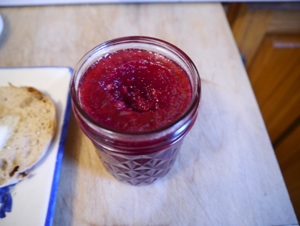
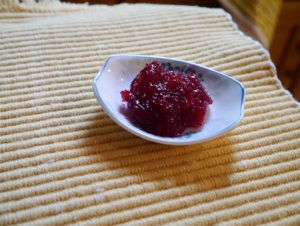
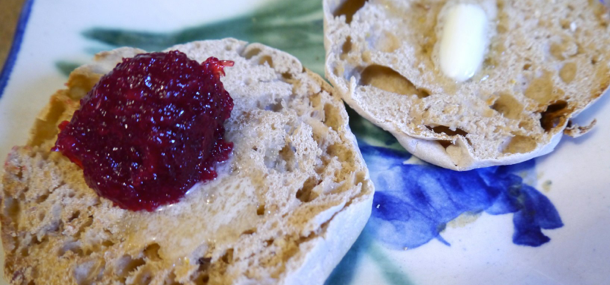
Back to the drawing board.


